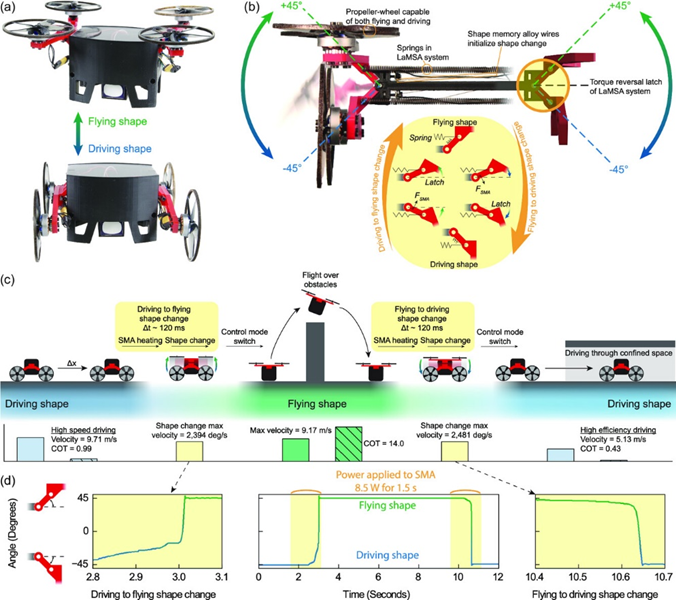THE CHALLENGE:
The field of robotics has seen significant advancements in unmanned vehicles for various applications, including search and rescue, environmental monitoring, and transportation. These diverse applications often require vehicles to operate in complex environments with varying terrains, necessitating adaptable locomotion capabilities. A single mode of transportation, such as flying or driving, often proves insufficient to navigate these challenging scenarios effectively. Thus, there's a growing need for robotic vehicles capable of multimodal operation, seamlessly transitioning between different locomotion modes to overcome obstacles and traverse diverse terrains.
Current approaches to multimodal robotic vehicles often fall short of the desired adaptability and efficiency. Existing designs frequently employ separate propulsion systems for each mode of locomotion, leading to increased complexity, weight, and power consumption. Furthermore, the transition between modes can be slow and cumbersome, requiring significant time and energy. Shape-morphing robots, while promising, often rely on traditional motors or adaptive materials with limitations like bulky form factors, high power usage, tethered operation, or lengthy morphing durations. These drawbacks hinder the development of truly agile and efficient multimodal robots capable of dynamic adaptation to complex environments.
OUR SOLUTION::
This robotic vehicle seamlessly transitions between driving and flying modes. Its chassis supports multiple rotors, each with a rim enabling rotational movement for driving when vertically oriented. For flight, the rotors shift horizontally to generate lift. This transition is achieved by a rotor actuation system using a spring-tensioned actuator and shape memory alloy (SMA). The SMA provides the force for rapid rotor repositioning, typically within 50 milliseconds. An electronic control circuitry manages rotor operations and the actuation system, ensuring smooth transitions. The rotors rotate unidirectionally for driving and multidirectionally for flying, with the system capable of reversing motor polarity to adjust rotation as needed. This single propulsion system efficiently serves both modes.
This technology differentiates itself through its integrated design and rapid shape-changing capability. Unlike other multimodal vehicles that use separate propulsion systems, this vehicle employs a single, dual-purpose rotor system for both driving and flying. This simplifies the design, reduces weight, and enhances efficiency. The bio-inspired, latch-mediated, spring-actuated (LaMSA) system, powered by SMA, enables exceptionally fast transitions between modes, significantly faster than traditional motor-driven systems. This speed, combined with the bistable nature of the LaMSA system requiring no power to maintain either shape, allows for agile maneuvering and adaptation to varying terrains. The entire system is untethered and remotely controlled, enhancing its versatility and potential applications.
ADVANTAGES:
- Multimodal operation: The vehicle can both fly and drive.
- Quick transition: Shifting between modes takes about 50 milliseconds.
- Single propulsion: One system for both flying and driving.
- Efficient design: Relatively lightweight and low power consumption, especially when driving.
- Untethered operation: All control and power systems are onboard.
- Wireless control: Remotely controlled for various functions.
- Shape-changing ability: Adapts to different terrains and environments.
POTENTIAL APPLICATIONS:
- Package Delivery
- Search and Rescue
- Aerial Inspection
- Surveillance
- Agriculture Monitoring

Figure 1
Overview of the LaMSA-driven, multifunctional morphing robot. a) Multifunctional robot in both flying and driving shapes. b) Overlaid images showing the motion of the wing in the flying-to-driving shape change, along with an inset showing the motion and driving forces of the LaMSA shape change. c) Example sequence of operations for the shape-changing robot, showing driving, flying, and multiple shape changes. Through these, relevant metrics are plotted on axes below the schematic. d) Angle of the morphing system over time for a switch from driving to flying mode, then a return to driving mode. The central plot shows the entire duration, while the left and right show just the driving-to-flying and flying-to-driving shape changes, respectively. The highlighted yellow regions represent moments during which electric power is applied.